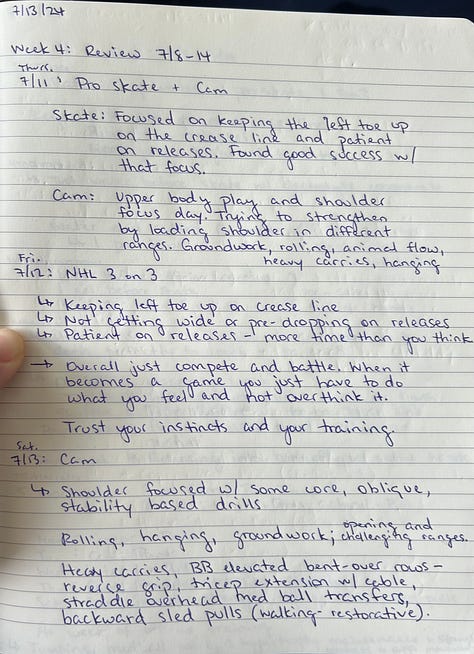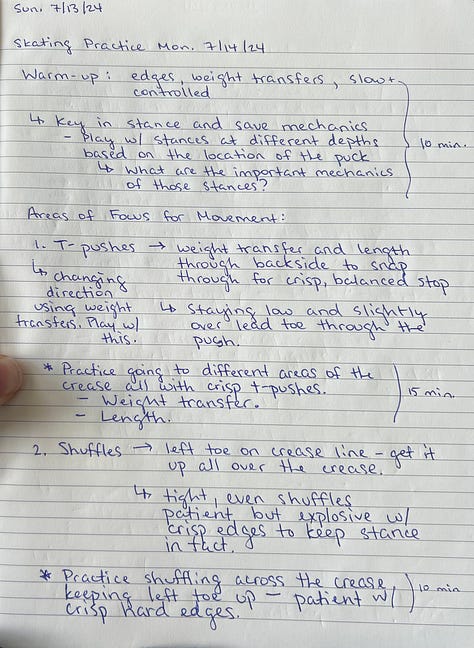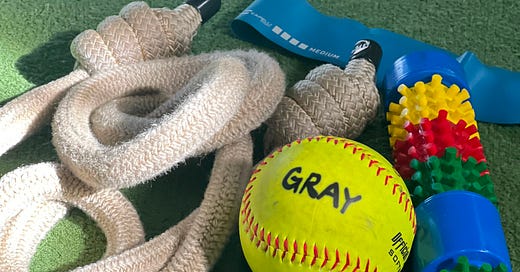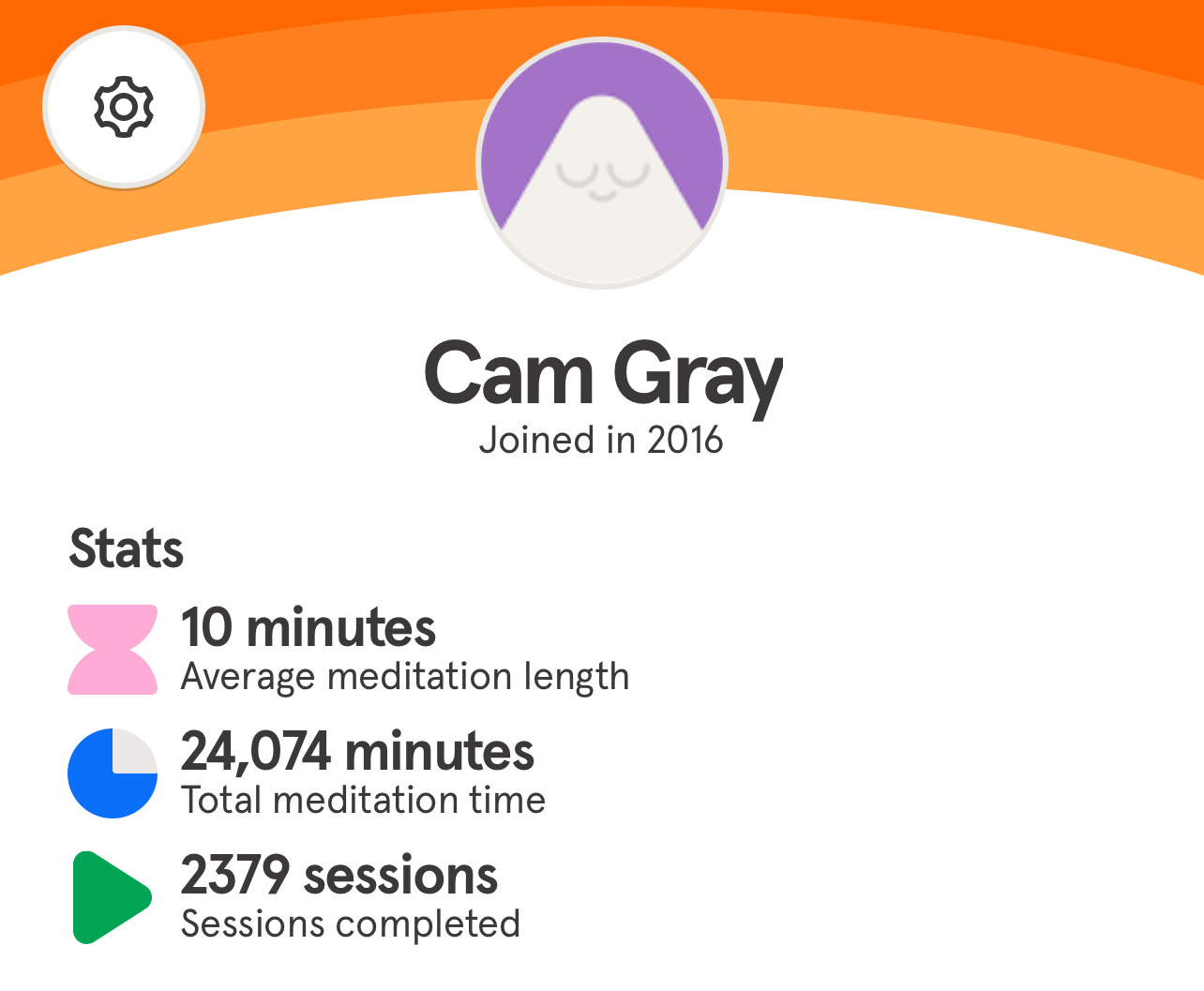Low- to No-Cost Training Tools for Goaltenders
Training tools and programs goaltenders can use to continue progressing towards their goals at home and on the road
A few weeks ago, I discussed the importance of consistent summer training for goalies looking to increase their level of competition and sustain development. While I understand the financial investment that most training requires, there are many ways to improve your goalie skills for little to no cost.
Today, I want to discuss my favorite low-to-no-cost training tools, which I use daily as a pro hockey goalie.
I carry most of these tools in a warmup bag that I keep inside my hockey bag. I go through the same warmup before every practice and game, using these tools to prepare my body and mind to compete at the highest level. If I am on the road or visiting family, I bring this bag with me to have the basic equipment to keep my body and mind in shape.
Mindset
Moleskine Journal - $20
The best tool I can recommend to any goaltender looking to make their dreams a reality. Start journaling. Write down your dreams and ambitions and how you will make them a reality. This is what we teach during our CG Goaltending Summer Camps Seminar portion, and it is how I went from a fourth-string college goalie to a National Champion and professional athlete. You can do it too.
Here are a few examples from my journal from last summer training in Toronto, ON, with my goalie coach and personal trainer.



I like the Moleskine journals because they are high-quality and will last a lifetime.
Headspace - FREE for teens ages 13-18
Been using this meditation app since I was 19, and it has changed my life and hockey career. As a teen and young adult, I dealt with depression and anxiety. Headspace helped me re-train my brain in how to deal with these troubling emotions, as well as performance anxiety and long-term focus.
Headspace has specific packs for dealing with life events and sports challenges. Two of my personal favorites, which I have completed dozens of times each, were created specifically for sports performance: Sports: Motivation and Sports: Concentration.
Almost 2,400 sessions later, and it still works for me.
Vision + Cognitive Training
Ares Elite FREE Sports Vision Drills - FREE
Free sports vision training drills from our partners at Ares Elite Sports Vision. Sharpen tracking, recognition speed, and decision-making - a must-try for all goalies.
The course is free - sign up and get after it!
Racquet Balls - $9
Must have for daily ball work and visual warmup drills. Do drills that mimic the mechanics of tracking a puck. 10-15 minutes daily, minimum.
Hacky Sack - $10
Hacky sacks are fun tools for challenging footwork and coordination. I incorporate them into my daily workout and warmup routines as a fun way to get warm and engage my feet and brain.
Swivel Vision Goggles - $45
Block peripheral distractions to strengthen focus and visual attachment.
I wear these goggles during off-ice ball drills to engage my eyes. While our peripheral system is critical to goaltending, I find most younger goalies have an issue with tracking pucks into their bodies/hands and rely solely on peripheral vision. This can lead to problems with accurately making saves and controlling rebounds.
I bought my pair close to 10 years ago, and they are still going strong!
Off-Ice Conditioning
Mini Bands - $7
Activate lower body stabilizers before lifts or ice. I use them for a series of exercises during every warmup. They can also be used for strength and mobility workouts and injury rehab.
Resistance Bands - $13
These are great for activation and dynamic patterns. I use them for dynamic movements with rows, punches, side lunges, and other athletic movements. Resistance bands can be purchased in different resistances, in loop bands, or with handles. I like to have a couple of options.
Flow Rope - $46
Biomechanics, rhythm, coordination, and endurance all in one. I rotate this into off-ice workouts to simulate movement patterns with flow and control. It is a full-body tool that can be used for conditioning, mobility, balance, and recovery. It is a very high-return piece of equipment.
Slam Medicine Ball - $29
Develop full-body explosiveness and rotational power. I use these for controlled, high-output sets that mimic the demands of power output in the crease, especially my ability to create rotational power through my core. This is another piece of equipment that has a high return on investment.
Mobility and Recovery
Exercise mat - $24
This is a must-have for at home AND the rink. It is used for stretching, recovery, and bodyweight movement sessions. I use it every day for mobility circuits and pre/post-skate mobility.
Softball - $8
It is perfect for deep tissue release and mobility in hard-to-reach spots. I use it daily to hit my hips, glutes, and upper back—it is non-negotiable for staying mobile and pain-free. You can also use a foam roller or lacrosse ball to target regions requiring more or less surface area.
The bottom line…
If I could only have 2-3 pieces of equipment for my off-ice routines, including warmup, cool-down, strength, conditioning, mobility, coordination, and recovery, I would prioritize:
Flow rope
Hacky sack
Slam ball
With this equipment, I can cover a wide range of functional exercises that improve my mobility in the crease and body weight exercises such as animal flow, plyometrics, and sprinting.
Goaltending is such a cerebral sport that training to be the fastest and strongest will not get the job done. You must train your brain and body to work together, in sync, and aligned with the natural laws of human biomechanics. Each piece of equipment incorporates the mind-body connection into the exercise: rope flow teaches you to coordinate and orient your body in space using natural laws of movement, hacky sack challenges your brain to make decisions with your feet, knees, and hips with rapid accuracy to string together touches, and slam balls teach you how to generate force and leverage your body.
Using this equipment and combining these exercises with animal flow movements and plyometrics, including jumping, throwing, and sprinting, you can create and execute a comprehensive off-ice training regimen with minimal equipment and financial commitment.
Now, I am not undermining the importance of lifting weights and doing workouts in a gym. Encorporating traditional lifting exercises, cables, and other machines into our routine will help develop base strength and build muscle and tendon volume. However, conventional gym-only training misses the mark by a long shot in hockey goaltending training. It oversimplifies the many proficiencies that go into elite goalie training.
Start building your off-ice equipment bag and develop efficient and effective routines. By intentionally focusing on executing your process daily and refining it over time, you will be on the path toward your fullest potential.
If you enjoyed this article and want to take your development further, subscribe to explore our training programs and weekly insights designed to help goaltenders reach their full potential!






